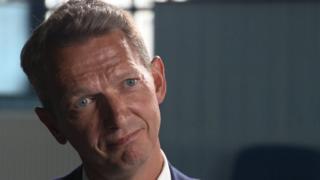Cornoavirus: UK has ‘clawed back’ half of fall in output

The UK economy has «clawed back» about half the fall in output it saw during the peak of the coronavirus lockdown in March and April, according to the Bank of England’s chief economist.
Andy Haldane told MPs there had been a «V» shaped «bounceback».
Last month, Mr Haldane said the economy was «on track for a quick recovery» – the so-called «V» shape.
However, other economists have expressed doubts about the potential for such a swift recovery in activity.
«Roughly half of the roughly 25% fall in activity during March and April has been clawed back over the period since,» Mr Haldane told members of the Treasury Select Committee. The economy had grown by about 1% per week, he said.
«We have seen a bounceback. So far, it has been a ‘V’. That of course doesn’t tell us about where we might go next,» he added.
The latest economic growth figures for May indicated an increase of 1.8%, but Mr Haldane is known to take into account unofficial real-time data, such as Google searches and credit card receipts.
Commenting on those figures at the time, Thomas Pugh, UK economist at Capital Economics, said the data showed the recovery was «maybe not so V-shaped after all» and that «hopes of a rapid rebound from the lockdown are wide of the mark».
«Indeed, the path to full economic recovery will probably be much longer than most people anticipate,» he added.
Mr Haldane was speaking at a hearing to reconfirm him as a member of the Bank’s Monetary Policy Committee (MPC).
He was the only member of the nine-strong MPC who last month voted against an expansion of quantitative easing – expanding the asset purchase programme aimed at boosting the economy.
However, he told MPs unemployment was rising fast and was probably about 6% now, compared with 3.9% in the most recent official figures.
He also repeated his fear that unemployment could hit its highest level since the mid-1980s as the long-term effects of the coronavirus pandemic hit demand for staff in retail and hospitality.
Analysis:
Dharshini David, BBC business correspondent
A speedy bounceback to activity, livelihoods and incomes is what we all hope for.
But most economists doubt it’ll be that straightforward or painless to get back to business as usual.
So far the official data hasn’t been encouraging. After losing a quarter of it’s output in the first six weeks of lockdown, output – or GDP – recouped only 1.8% in May.
Mr Haldane is known to be fond of more up-to-date unofficial data – Google searches, credit card transactions for example. That’s why he’s hopeful we’re halfway back to the previous level of activity.
But even if it is so far so good, the real issue is what happens next.
The Bank of England expects unemployment to jump to 9% – but it’s unusual in assuming that will fall back quickly, with no long-term fallout, or scarring, on prospects and incomes.
It is that risk that most other analysts worry will derail confidence and spending – the underpinnings of any recovery.
So the hoped-for V could look quite different. And that’s even before the possibility of a second wave and shutdown is considered.

